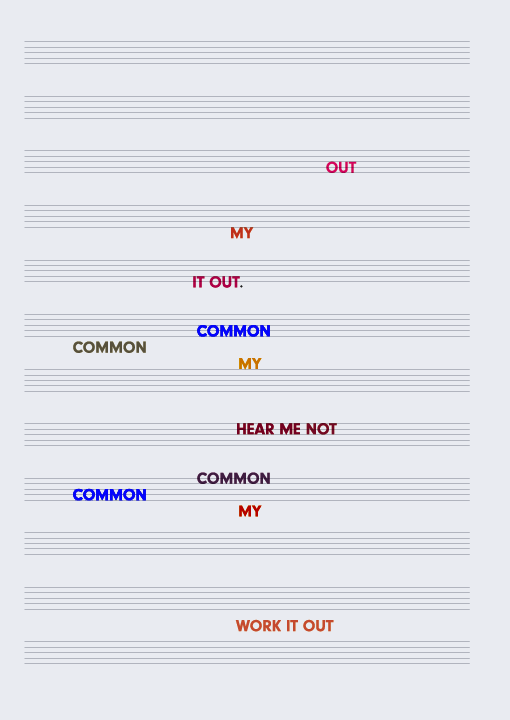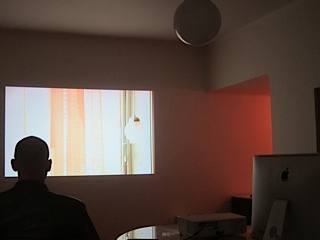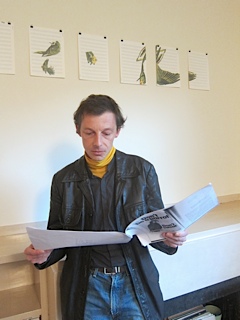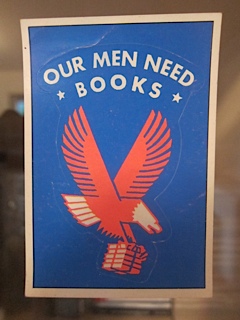FOUND IN TRANSLATION, chapter P like Politics, P like Parrots Eleni KAMMA

What on earth would at first sight appear to connect a conversation between two Swedish architects reflecting on a current trends in architecture, excerpts from presidential speeches by G.W. Bush, the weekly practice of an amateur choir and the archetypal image of parrots in our Western imagination ?
Hardly anything, one would guess.
And still…

What would seem to be a kind of rebus comes into pieces when one takes the necessary “speculative†time to visit and envision thoroughly the installation devised by Eleni Kamma for Maison Grégoire.
For Eleni Kamma’s work is a work which unfolds itself in permanent translation (hereby intended in its etymological meaning of “bringing beyond†), much in the fashion of an associative and inductive discourse, where gaps and voids are precisely as meaningful as its formal constitutive and explicit, expressed elements.
It is a work which, following a seemingly casual, but, at the same time, very specific and selective approach, resorts to visual, plastic and linguistic elements to articulate itself into gesamtkunstwerk installations. Kammas installations and or exhibitions are to be apprehended in totum, like a free floating sentence elaborated in a personal language, resorting to an eclectic vocabulary.
The works forming the chore of this exhibition are two videos, both realised in Sweden on the occasion of Eleni Kamma’s residency @ Iaspis in 2011, namely :
Malin and Tor : Two architects in conversation
and the eponymous :P like Politics, P like Parrots
Both videos are at first sight or, rather first hearing, strongly anchored by their discursive and linguistic content in the Swedish local context.
Beyond, it is maybe this very displacement out of their context of origin which helps appreciate the general, meta-linguistic message and the socio-political and aesthetic comments they convey.
Malin and Tor : Two architects in conversation follows in two episodes the discursive exchanges between the two aforementioned architects.
The fist part of their conversation articulates around an analysis of the crisis of the speculative element in contemporary architecture, paired with a reflexion on the “spectacular†fashion, as a current operational mode, mirrored by the very alteration of the meaning of their etymological radical.
Background for this video is the mobile, evolving and precisely anti-spectacular setting of a room of the Arkitektuurmuseet, filmed while an exhibition is being mounted.
As such, through the very explorative and rotating use of the camera, the decor functions as a sort of fragile organic filter, acting as a meaningful metaphoric counterpoint to a reflexion of the spectacular role / dimension of architecture in the social fabric.
In the second part of the video, the two architects resume their conversation by tackling i.a. the phenomenon of the success and flowering of singing choirs apprehended as a sort of social architecture, which may sometimes be seen as “absorbing the lack of talents†, whilst revealing the need of a sense of community and offering the possibility for a mediated discursive social expression.
This part of their conversation offers the natural transition for Kamma’s second video, reflecting a specific rehearsal of the amateur choir of the Parish of Bräcke.

The composition of the text proposed by Kamma and rehearsed by the singers, originates in the rhythm and structure of the famous hands game “Paper-Rock-Scissors†progressively subverting it through the inclusion of political P- words, all (not so) randomly chosen from a 2003 speech by George W. Bush and introducing the concepts of public, common sphere vs. private one, power vs. people etc.

The casually repetitive, alternating character of the seemingly endless game offers an indirect metaphor on the arbitrary functioning of our political systems, apprehended as a carousel-like vortex.
If their correspondences appear but progressively, the two videos function very well together.. They share the same use of an explorative camera, rotating around itself in a seemingly empty décor, just inhabited by the characters through speech or singing. An articulated but also free and associative discourse in the first video makes place in the second video for a more polyphonic and seemingly loose verbal exchange, nevertheless carefully devised and prepared by the artist.
Both discursive contents progress and develop in associative translations of meanings and / or phonetics to eventually climax in the P like Politics piece in a parody of a subversive sung “game†. It there where one can feel that the formal and thematic choices made within each video (and in the link between the two of them) are deeply meaningful.

The domestic interior of Maison Gregoire appears to be the perfect setting for the presentation of the two videos. The premises combine the purity of their modernist lines along with a decidedly domestic, lived in (if sparsely furnished) interior, thus echoing the two distinctive backgrounds filmed in the Eleni kamma’s videos. Precisely conceived by van de Velde as an anti-spectacular statement, the architecture is organically articulated and based on human scale. A final touch is brought about by the fact that the ground floor used for the exhibitions is designed for a circular de-ambulation around a central staircase, thus much on the line of the circular rotating character of the filming in Kamma’s videos.

On the occasion of Found in Translation, chapter P, an original silkscreen print, booklet and a series of 15 prints further articulate the implicit connection between the videos.
Opening on 4 october 2012, 6 30 p .m.
Exhibition open on Saturdays, 2-6 p.m. from 04 / 10 / 2012 until 03 / 11 / 2012
Maison Grégoire
292 Dieweg
B 1180 Bruxelles
www.maisongregoire.be